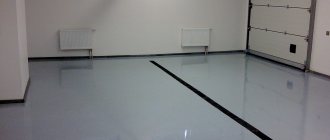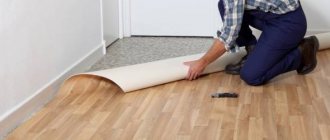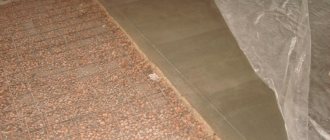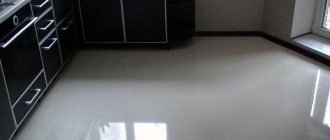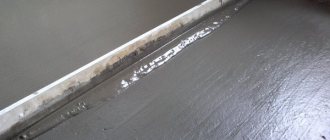Using putty, you can significantly improve the aesthetic and technical characteristics of the surface of a wooden or concrete floor, increase its resistance to external influences and, in the case of a wooden floor, maintain a unique wooden texture for a long time. Floor putty is used to eliminate defects that appear during the operation of the floor, as well as for high-quality preparation of the base for decorative finishing. How to choose the composition and do the job correctly? We'll tell you in this article.
Floor putty
Concrete floor putty
When renovating, it is important to qualitatively prepare all surfaces for coating and decoration, be it a wall, floor or ceiling.
The concrete floor itself is very strong and reliable, but sometimes it has cracks, chips and crevices. To avoid huge costs for floor repairs in the future, you need to use building mixtures and putties.
Treated concrete floors have a number of advantages: high wear resistance, low likelihood of erosion, less susceptibility to abrasion, chemicals and moisture.
Is it possible to make a smooth surface using putty?
The concrete base has a high degree of strength . But if there are small defects on it in the form of cracks, chips, pores, poorly puttied joints, the base begins to collapse. Repair costs cannot be avoided. Additional reinforcement of the floor with putty provides several useful advantages:
- creates high wear resistance;
- increases resistance to erosion;
- creates resistance to abrasion and mechanical damage;
- makes the surface impervious to the influence of chemical reagents;
- prevents accumulated moisture from entering the base, which also preserves the durability of the structure.
Application of putty
Most often, concrete floors without finishing material can be found in industrial buildings - factory workshops, garages, retail and warehouse premises, etc. Here the most important requirement for concrete is strength to mechanical loads and wear; in addition, floors are provided with resistance to physical and chemical influences, temperatures, moisture, etc.
For which coatings is treatment with putty for a concrete floor relevant: under parquet and parquet boards, laminate and linoleum, ceramic tiles and painting, porcelain tiles and self-leveling polyurethane floors. These materials require a perfectly smooth and even surface, resistant to mechanical damage and moisture, capable of not crumbling, cracking, or dusting.
Putty for concrete floors performs the following functions:
- Increases the level of water resistance.
- Significantly increases mechanical strength and wear resistance.
- Reduces the amount of dust emitted by the screed.
- Significantly extends the service life of both the concrete floor itself and the coating laid on top.
- Ensures safety and environmental friendliness of use.
- Improves adhesion between materials.
Properties
Putty is selected in accordance with the functions it must perform. So, for example, for floors in industrial premises it may be important to ensure maximum wear resistance and strength, for certain residential premises - to minimize exposure to moisture and temperature changes.
Putties are selected according to the type of finishing coating, the purpose of the room, the functions of the floor and other factors. The modern market offers a fairly large selection of various compositions, most of which meet basic requirements, while for specific ones it is important to select specific substances.
Types by composition
Depending on the materials used for manufacturing, there are two main types of putties for concrete floors:
The last type of product is most often used to level the floor in extremely dry, not very frequently used rooms. In most cases, concrete surfaces are puttied using cement compounds. It is these products that give surfaces additional strength.
Sometimes apartment owners can also use polymer putties for concrete floors. Such products can be used in both wet and dry areas. But putties of this variety are quite expensive. Therefore, they are usually used only for adjusting floors in small rooms.
Polymer putties are also often used for self-leveling floors. In this case, the best adhesion between the surface and the adjustment layer is ensured. After all, self-leveling floors are usually installed using polymer compounds.
How to level a floor under linoleum: detailed instructions on how to do it
To lay linoleum, you need a flat base, otherwise the coating will not last long, and its appearance will be poor. For wooden and concrete floors there are several leveling methods, each of which has its own differences; the article will provide detailed instructions.
This article talks about why leveling is needed, how best to fix a wooden floor, how to smooth a concrete surface, and what tools and materials are needed for this.
Types of putty
There are several classifications.
Depending on the nature of use, mixtures are divided into:
- basic – used in contact with concrete or cement;
- finishing – used for final surface finishing work;
- universal - used in both cases.
Return to contents
Basic putty mixture
Basic or, as they are also called, starting putties are used to level out even the most significant unevenness.
They are applied in a thick layer. This material is usually presented in dry form, so proper preparation of the mixture is also important. The consistency should be elastic and moderately liquid. To achieve the desired result, one layer will not be enough. After the first layer has dried, it must be sanded and another one or more layers applied. An example of a high-quality base putty is a solution from.
Finishing putty mixture
The finishing putty is applied over the base putty. Their task: a smooth and even surface. The peculiarity of its application is a thin layer that lies on a perfectly polished concrete floor or walls. Most often, manufacturing companies of this building material indicate the recommended layer thickness on the packaging. Putty mixtures are not intended and should not be applied in a wide layer. An excellent finishing putty is Ceresit brand putty.
Universal putty mixture
The name of this type of finishing materials speaks for itself.
This mixture is a product that can be used both as a base putty and as a finishing putty. The working surface can be anything. This category is not without its shortcomings. What deters buyers the most is the high price. In addition, putty of a separate direction is much better in quality, in contrast to universal putty. The main representative of this category is the Novol brand solution. As for the component composition, it also serves as the subject of classification. There are mixtures based on:
- cement;
- gypsum;
- limestone;
- oils;
- glue;
- varnish;
- polymer or acrylic.
Return to contents
Cement putty
This mixture is the most popular on the building materials market. This conclusion is based on the fact that one of the main components of putty is most often cement. The binder can be represented by two brands - M500 and M400.
Among the advantages of this category are:
- water resistance;
- high moisture tolerance.
- during the drying process, the mixture shrinks, which leads to the need to apply additional layers;
- lack of elasticity of the material;
- the appearance of small cracks after some time;
- inconvenience of application on a smooth surface;
- not very high productivity;
- swells upon contact with wooden surfaces.
Among the representatives of cement putty, the brands Knauf, Ilmax, Ceresit and others are distinguished.
Gypsum putty
Based on the name itself, we can come to the conclusion that this mixture is based on gypsum.
The peculiarity of this material is that it can be used in rooms of any humidity. In addition, its properties lead to natural circulation of moisture. When choosing such putty, the following advantages are especially appreciated:
- Possibility of application to plastered surfaces;
- high thermal insulation;
- dries quickly;
- fire resistant;
- reasonable price considering the quality;
- does not have a negative effect on humans.
Disadvantages are also present:
- not used for work on the facade of the structure;
- use in rooms with unstable temperatures is undesirable;
- not used for finishing swimming pools and bathrooms;
- easily damaged;
- has a negative corrosive effect on metals.
Use of polymer putties
Concrete putty is intended for waterproofing and leveling the cement or concrete base of the floor before applying the main coating to it. The diluted putty mixture, when spread, fills cracks, cavities, potholes and small irregularities in concrete, forming an even and durable film after hardening and drying.
Polyester leveling putties must be applied in thin layers, no more than 2 mm thick. Each subsequent layer is applied after the previous one has dried; as a rule, it is enough to apply 2 layers of putty.
Before leveling the concrete, its surface must be thoroughly cleaned of dust, debris, remnants of old flooring, glue, paint and foreign objects. If there are greasy stains, the surface is degreased with organic solvents and, if necessary, coated with primers. It is acceptable to apply putty to damp or fresh concrete.
Tools for putty.
The polymer putty mixture is diluted with water using a construction mixer according to the instructions given on the package, usually in a ratio of 1:5, in the presence of small cracks and dents. If the floor surface is fairly flat, the dilution ratio can be 1:3. The amount of finished putty should be relatively small, since in its finished form it has a limited time of use, ranging from several tens of minutes to several hours, depending on the composition. Most often, manufacturers indicate a period of use of the finished putty of no more than 4 hours, after which it hardens and loses its properties.
The finished solution is poured onto the prepared surface and leveled using a soft comb spatula or brush. The putty layer must be even and thin enough, otherwise cracks may appear on the surface when the polymer putty composition dries. The mixture consumption per 1 m² of concrete base surface is 2-4 kg. After the polymer film has hardened, excess material is removed with a sharp spatula, and surface unevenness is sanded with emery cloth.
The final top layer of putty is applied after the base layer has completely dried. This time is about a day in a dry, ventilated room at room temperature.
Waterproofing polyurethane material
Waterproofing is characterized by increased resistance to the effects of organic and mineral environments, mechanical strength against tearing and compression.
Waterproofing putty is used both in combination with other materials and as an independent coating.
Application
Scheme of concrete hardeners.
- This type is used for waterproofing concrete floors, for sealing cracks (including small ones) and for creating a waterproofing protective layer under a self-leveling floor system. The putty can be applied to a damp base and to fresh concrete;
- putty is used for waterproofing water tanks and swimming pools, under cement screeds and tiles, wastewater treatment plants and sanitary facilities, as well as for external waterproofing of foundations;
- this waterproofing coating is environmentally friendly and can be used in explosion and fire hazardous areas;
- consumption depends on the thickness of the layer and is 1.5-4.0 kg/m2;
- after completion of work, the tool is cleaned with water;
- The composition includes a 3-component urethane compound, consisting of a semi-finished product (urethane film former with targeted additives and an aqueous dispersion), a dry mixture and a hardener.
Storage
- the semi-finished product is stored at a temperature of at least +5°C;
- The shelf life of hydrospar in original packaging is 12 months from the date of manufacture.
What mixtures are suitable for restoration?
Acrylic
Acrylic composition is used to level floors with minor defects (chips, cracks, potholes). Suitable for restoration of floors on which parquet or linoleum will be applied. No solvents are used for use. The composition looks like a thick, stretchy paste that is easily distributed over the surface with special tools.
At sub-zero temperatures, the acrylic composition has one drawback - it loses elasticity. Advantages of acrylic putty:
- hardens quickly;
- harmless to the body;
- easy to apply and level;
- has plasticity;
- does not allow water to pass through, which prevents the formation of fungus;
- without smell.
Due to the fact that acrylic putty has very high performance and technical characteristics, its price is much higher than other analogues.
It must be applied in a very thin layer (about 1–2 mm). In this case, it will be possible to avoid cracking of the surface after complete drying.
Polymer for wood coverings
The polymer mixture is also called latex or acrylic. Its use is justified for wooden floor coverings and parquets.
The mixture consists primarily of water. Suitable for coating on wooden surfaces due to its high leveling properties. The composition does not shrink; it is enough to cover the surface with one layer of putty. Polymer compositions have a number of advantages:
- resistant to temperature changes, sudden pressure surges, and humidity;
- has water-repellent properties;
- can withstand high loads for many years without a single visible deformation;
- elasticity;
- elimination of all cracks and voids in wood;
- complete filling of joints between boards;
- does not shrink after drying;
- durability of the coating;
- many shades;
- instant drying;
- safety in use, environmental friendliness.
Quick drying
It contains solvents and plasticizers. It has a pungent odor that dissipates within a few days after application. The advantage of applying a quick-drying mixture is its uniform distribution over the entire pouring area, filling all joints, cracks and kinks.
The base is pre-cleaned well and treated with a primer. This is necessary for a better fit of all subsequent materials. To work, you will need beacons that will indicate the height of the screed above the level of the walls. After distributing the self-leveling mixture, wait about an hour and pull out the beacons. The recesses from them are sealed with the same putty material.
The advantage of applying such a mixture is the minimal investment of labor costs. The surface is perfectly leveled with one tool - the rule. Manipulations with it are quite simple.
Oily
Oil mixtures have a high water-repellent effect and provide surface resistance to mechanical stress. Thanks to the wide range of shades of oil putty, you can choose it to match any wood texture.
What is the best way to fix wood flooring?
Wooden bases are a common occurrence in Soviet apartments, country houses, and cottages.
Over time, the wooden flooring becomes deformed, cracks and gaps appear, and therefore it must be leveled before laying linoleum. Alignment methods:
- Cycling.
- Coating with putty.
- Installation of plywood panels.
- Use of dry self-leveling mixtures.
Let's talk about each of them in more detail.
Cycling
For sanding, it is best to use a sanding machine, but if you don’t have one, a regular plane will do. Processing begins from the far wall towards the doors.
Rules for using the scraping machine:
- make sure that there are no metal objects on the floor or nails sticking out;
- use special headphones when working;
- use a respirator to prevent dust from entering your respiratory tract;
- The device is noisy, so carry out work within the permitted time.
Processing by scraping takes place in 2 stages.
- After the first cleaning, the surface must be covered with putty, eliminating all defects. When it dries, you can begin secondary processing.
- Once leveling is complete, vacuum the room, treat the base with an antiseptic, and then coat it with a protective varnish. Then you can start laying linoleum.
Putty
The method of leveling with putty depends on the type of material chosen:
- For wooden surfaces, a composition of sawdust with glue is suitable, which will cope even with minor defects. Such mixtures are good protection against moisture, noise, and unwanted insects.
- Dry putty mixtures, which are diluted to a creamy consistency and applied to the sanded surface.
- Simple dry putty is the most economical, but labor-intensive way to cover a wooden floor.
Plywood
This method is suitable for situations where you need to level a floor installed at an angle.
Plywood panels laid in two layers make it possible to bring the floor level to a horizontal level. Sanded sheets with a thickness of 10 mm will be optimal. The work order is as follows:
- Plywood sheets are divided into squares measuring 60x60 cm. In this case, the material must be smooth, without chips or cracks.
- Then self-tapping screws are screwed in at a distance of 20–30 cm from each other, which will serve as beacons.
- Logs are installed on the floor - support beams made of plywood. The width of the logs should be 3–4 cm. Self-tapping screws or wood glue are used for fastening, and the space between the beams is filled with insulation.
- Plywood panels are mounted on the prepared logs with self-tapping screws, and the gaps between the sheets are puttied. When laying, plywood must be treated with an antiseptic.
- The final coating is sanded and coated with a protective varnish.
In order for a plywood floor to last a long time, it is recommended to use a special underlay, on which linoleum is subsequently laid.
Self-leveling mixtures
Dry flooring mixtures allow you to achieve a perfectly smooth surface. Instructions for diluting the mixture are indicated on the packaging, and anyone can master the filling technology:
- The base is cleaned of dust and dirt. Cover with a primer to make the coating more airtight.
- A reinforcing mesh is installed to give the surface strength.
- The prepared mixture is poured into wide strips (about 30–40 cm) and spread with a wide spatula. Then you need to go over the mixture with a needle roller so that there are no bubbles.
- A layer of sealant is applied along the walls. All work must be done quickly, since the “lifetime” of the self-leveling mixture is short.
- When the first layer has dried, proceed to the finishing coat.
Types of putties
You need to select the material based on the type of rough foundation. This is usually concrete, or wood, or concrete leveled with sheets of plywood. The joints between them will also have to be puttied. In addition to specific compositions intended for a particular type of floor, there are also universal ones that can be used to work on both wood and concrete.
Wood putty
The compositions are used not only for straightening floors before laying linoleum, but also for restoring old wooden surfaces. They are also used to improve the appearance of floorboards. Wood putty can perfectly seal cracks, seams, fallen knots and other imperfections on a wooden surface.
Features of the composition for work inside residential premises:
- Elasticity. This parameter is necessary because wood can expand and contract depending on the surrounding temperature. If the putty is not elastic, it means that soon it will simply fall off.
- Uniformity (smallest fraction). Do not use coarse-grained compounds on wood. When sanding, scratches may appear, which will also have to be puttied.
- High adhesion. The composition must adhere perfectly to the wood, otherwise the putty will quickly begin to peel off and fall out.
- Ecological cleanliness. This parameter is important because the presence of harmful volatile substances in the composition can harm human health when dried.
- High antiseptic properties. For wooden floors covered with linoleum on top, it is very important that mold does not settle on them and that the process of rotting does not begin in the event of accidental water seepage through the finishing coating.
- Fire safety. Important, but not required parameter.
Oil-based formulations
Oil putties include drying oil, fillers, water, coloring pigments, plasticizers and other components. Such compositions are considered ideal for wood, as they have natural ingredients. The advantages of oil putties include:
- high plasticity;
- high adhesion to wooden surfaces;
- moderate consumption (no more than 1 kg/m2);
- ease of use;
- fairly quick drying;
- environmental safety;
- relative cheapness.
Unlike most other putty mixtures, leveling oil compositions go on sale ready-made. They do not require pre-mixing before application to the surface to be treated.
Despite the many advantages, the material also has quite serious disadvantages. Putty can quickly “fall out” of cracks and potholes if the floor is subject to intense stress. Oil-based compositions are sensitive to excess moisture and do not adhere well to any paint other than oil-based paint. Therefore, before working on plywood or wood floors, you will have to strip them of any finish down to the wood itself.
Quick-drying compounds
Nitro putties are made from wood dust (flour), have a wide variety of colors, and dry very quickly. Among the advantages:
- excellent adhesion to wooden substrates;
- ideal sealing of defects;
- the ability to process a wooden surface (clean, polish);
- dry within a maximum of 10 minutes;
- Ordinary acetone or nitro solvent is suitable as a solvent.
Basic requirements for materials
As a rule, floors in residential, office or industrial premises are subject to significant mechanical loads during operation, as well as exposure to moisture, detergents and other chemically active substances. In this regard, concrete putty, according to its characteristics, must have a number of mandatory properties, such as:
- mechanical strength;
- high adhesive properties;
- moisture resistance and water resistance;
- operational safety;
- durability;
- wear resistance.
According to the nature of use, putties or putty mixtures are divided into:
- basic, directly in contact with a concrete or cement base;
- finishing, used for final smoothing of the floor surface;
- universal, which can be used in both cases.
The simplest and most convenient to use are liquid polymer-based compositions that have self-leveling properties. When such mixtures are applied to a concrete floor, they are spread in a thin layer, forming an even coating film that is practically not subject to deformation and shrinkage.
Scheme of waterproofing a concrete floor.
Typically, polymer putty contains fillers, a polymer binder, hardeners and stabilizers, as well as various reinforcing additives. Water-based polyurethane or polyester is most often used as a polymer binder base for putties. Delivery is carried out in the form of mixtures, including from one to three components, diluted with water before application to the surface to be treated during operation. Dry putty mixture or its individual components are stored at a temperature not lower than +5°C.
Choice depending on the type of base
One of the main criteria for choosing a putty is the type of surface you will be working with. This can be wood (boards, plywood, parquet, fiberboard or chipboard), gypsum fiber sheets or concrete. To work with the latter, cement putty with a waterproof effect is used. With its help it is possible to produce a very durable surface.
Each type of base requires special qualities from the putty. So, for working with wood, the composition should be:
- Plastic throughout the entire stage of work.
- Do not form cracks on its surface after drying.
- Create an organic combination with paintwork finishes.
When working with chipboard, the working composition should not shrink. This quality is typical for acrylic, latex and silicone putties. Oil and adhesive compositions successfully cope with large cracks.





